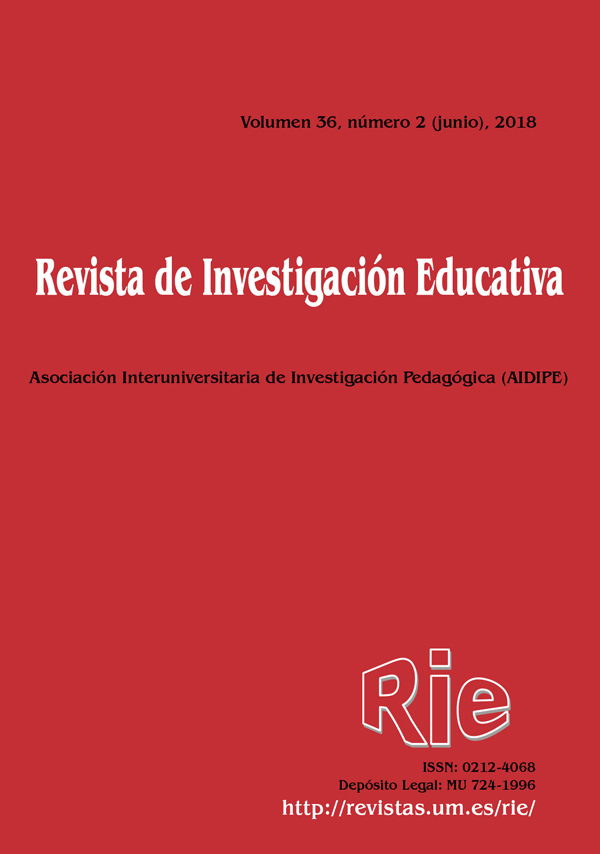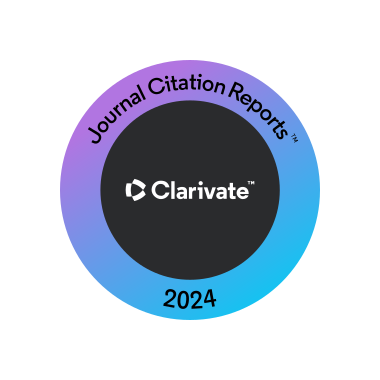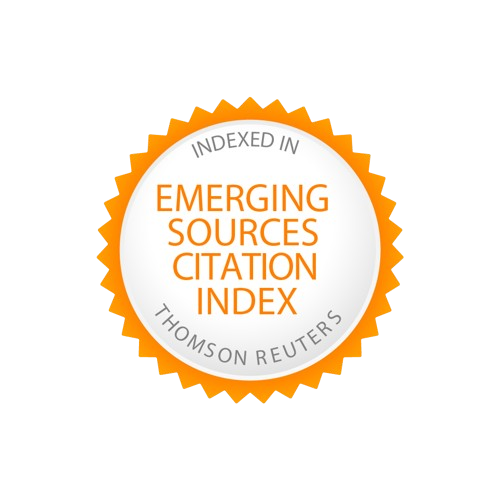Technology acceptance Model in higher education
Supporting Agencies
- Proyecto de investigación I D concedido por el Ministerio de Ciencia e Innovación del Gobierno de España (clave
- EDU2014_57446P) denominado “Realidad Aumentada para Aumentar la Formación
- (RAFODIUN)”
Abstract
In the last decades, the incorporation of online learning platforms to higher education means that students live with an unknown element in their social lives. So, their involvement with technologies depends on a number of factors. Through the Technology Acceptance Model (TAM) of Arteaga and Duarte (2010), created by Devis (1984), which is based on the psychological theory of Azjen and Fishbein (1980), the opinions of primary education degree seeking students at the University of Cordoba (N=546) were collected. Specifically, their opinions on Moodle, a platform to develop online training at said university, through the establishment of 23 working hypotheses. The main results have been confirmed that the English model can be applied in a Spanish context without risk of loss or information bias. On the other hand, it has been found that sex is not a predictor of success or failure in the acceptance of this technology nor the previous training thata student has. The use of TAM in Spanish higher education will revert to a more efficient way of emerging technologies that are incorporated more and more everyday into university teaching.
Downloads
-
Abstract3311
-
PDF (Español (España))2109
References
Aguilar-Luzón, M.C., Berrios-Martos, M.P., & López-Zafra, E. (2012). El uso de sistemas informáticos en el estudio de las materias universitarias: aplicación de la teoría de la conducta planificada y de la teoría de la aceptación de las tecnologías. Estudios de Psicología, 33(2), 179-190.
Ajzen, I., & Fishbein, M (1980). Understanding attitudes and predicting social behavior. Englewood Cliffs, NJ: Prentice-Hall.
Alharbi, S., & Drew, S. (2014). Using the Technology Acceptance Model in Understanding Academics’ Behavioural Intention to Use Learning Management Systems. International Journal of Advanced Computer Science and Applications, 5(1), 143-155.
APS Group Scotland (2015). Literature Review on the Impact of Digital Technology on Learning and Teaching. Social Research, 2, http://www.gov.scot/Resource/0048/00489303.pdf
Arenas, J., Peral-Peral, B., & Ramón-Jerónimo, M. (2014). Gender in the Elderly Internet Users. En I. Gil Pechuán, D. Palacios-Marqués, M. Peris-Ortiz, E. Vendrell, C. Ferri- Ramírez (Eds.), Strategies in E-Business (pp. 67-76). http://dx.doi.org/10.1007/978-1-4614-8184-3
Arteaga, R., & Duarte, A. (2010). Motivational factors that influence the acceptance of Moodle using TAM. Computers in Human Behavior, 26(6), 1632-1640. http://dx.doi.org/10.1016/j.chb.2010.06.011
Bandura, A. (1990). Perceived self-efficacy in the exercise of personal agency. Revista Española de Pedagogía, 187, 397-427.
Bao, Y., Xong, T., Hu, Z., & Kibelloh, M. (2013). Exploring gender differences on general and specific computer self-efficacy in mobile learning adoption. Journal Educational Computing Research, 49(1) 111-132. http://dx.doi.org/10.2190/EC.49.1
Buchanan, T., Joban, S., & Porter, A. (2014). Internet self-efficacy does not predict student use of Internet-mediated educational technology. Research in Learning Technology, 22, 1-14. http://dx.doi.org/10.3402/rlt.v22.19585.
Bullón, P., Cabero, J., Llorente, Mª C., Machuca, Mª C., Machuca, G., & Marín, V. (2009), Competencias tecnológicas del profesorado de la Facultad de Odontología de la Universidad de Sevilla. Sevilla: GID
Cabero, J., & Barroso, J. (2016). The educational possibilities of Augmented Reality. NAER, 5(1). 44-50. http://dx.doi.org/10.7821/naer.2016.1.140
Cabero, J., Leal, F., Andrés, F., & Llorente, M.C. (2009). La alfabetización digital de los alumnos universitarios mexicanos. Enseñanza & Teaching, 27(1), 41-59.
Colorado, A., Marín, V., & Zavala, Z. (2016). Impacto del grado de apropiación tecnológica en los estudiantes de la Universidad Veracruzana. IJERI, Revista internacional de Investigación e Innovación Educativa, 5, 124-137.
Chen, B., Sivo, S., Seilhamer, R., Sugar, A., y Mao, J. (2013). User acceptance of mobile technology: a campus-wide implementation of blackboard’s mobileTM learn application. Journal Educational Computing Research, 49(3) 327-343. http://dx.doi.org/10.2190/EC.49.3.c.
Chen, Y-H., & Chengalur-Smith, I. (2015). Factors influencing students’ use of a library Web portal: Applying course-integrated information literacy instruction as an intervention. Internet and Higher Education, 26, 42-55. http://dx.doi.org/10.1016/j.iheduc.2015.04.005.
Cheng, Y., Lou, S., Kuo, S., & Shih, R. (2013). Investigating elementary school students’ technology acceptance by applying digital game-based learning to environmental education. Australasian Journal of Educational Technology, 29(1), 96-110. http://dx.doi.org/10.14742/ajet.65.
Davis, F. D. (1989), Perceived usefulness, perceived ease of use, and user acceptance of information technology. MIS Quarterly, 13(3), 319–340. http://dx.doi.org/10.2307/249008.
Escobar, T., Carvajal, E., & Monge, P. (2014). Factors that influence the perceived advantages and relevance. Australasian Journal of Educational Technology, 30(2), 136-155. http://dx.doi.org/10.14742/ajet.585.
Gámiz, V., & Gallego, M.J. (2016), Modelo de análisis de metodologías didácticas semipresenciales en Educación Superior. Educación XX1, 19(1), 39-61. http://dx.doi.org/10.5944/educxx1.15577
García-Lirios. C. (2012). Estructura híbrida de los determinantes sociodemográficos del consume electrónico. Revista de Psicología GEPU, 3(2), 43-53.
George, D., & Mallery, P. (2009). SPSS for Windows step by step: A simple guide and reference.17.0 Update. Boston: Allyn & Bacon.
González-Bravo, L., & Valdivia-Peralta, M. (2015). Posibilidades para el uso del modelo de aceptación de la tecnología (TAM) y de la teoría de los marcos tecnológicos para evaluar. Revista Electrónica Educare, 19(2), 181-196. http://dx.doi.org/10.15359/ree.19-2.11
Hernández, R., Fernández, C., & Baptista, P. (2014). Metodología de la investigación. (6ª. ed.). México: McGraw Hill Interamericana.
Herrero, R., González, I., & Marín, V. (2015). Formación centrada en adquisición de competencias. El caso del grado de educación primaria. Revista de Ciencias Sociales, XXI (4), 461-478.
Ho, L-H., Hung, Ch-L., & Chen, H-Ch. (2013). Using theoretical models to examine the acceptance behavior of mobile phone messaging to enhance parent–teacher interaction. Computers & Education, 61, 105-114. http://dx.doi.org/10.1016/j.compedu.2012.09.009.
Hohlfeld, T., Ritzhaupt, A., & Barron, A. (2013). Are gender differences in perceived and demonstrated technology literacy significant? It depends of the model. Education Technology Research and Development, 61(4), 639–663. http://dx.doi.org/10.1007/s11423-013-9304-7.
Hsiao, C.H., & Yang, C. (2011). The intellectual development of the technology acceptance model: A co-citation analysis. International Journal of Information Management, 31(2), 128-136. http://dx.doi.org/10.1016/j.ijinfomgt.2010.07.003.
Jin, C.H. (2014). Adoption of e-book among college students: The perspective of an integrated TAM. Computers in Human Behavior, 41, 471-477. http://dx.doi.org/10.1016/j.chb.2014.09.056.
Jou, M., & Wang, J. (2013). Observations of achievement and motivation in using cloud computing driven. Computers in Human Behavior, 29(2), 364-369. http://dx.doi.org/10.1016/j.chb.2012.08.001.
Kang, M., & Shin, W. (2015). An Empirical Investigation of Student Acceptance of Synchronous E-Learning in an Online University. Journal of Educational Computing Research, 52(4), 475–495. http://dx.doi.org/10.1177/0735633115571921.
Kumar, S., & Kumar, J. (2013). Technology acceptance model for the use learning through websites among students in Oman. International Arab Journal of e-Technology, 3(1), 44-49.
Lee, D., & Lehto, M. (2013). User acceptance of YouTube for procedural learning: An extension of the Technology Acceptance Model. Computers & Education, 61, 193- 208. http://dx.doi.org/10.1016/j.compedu.2012.10.001
Lim, K., & Meier, E. (2011). Different but similar: computer use patterns between young Korean males and females. Education Technology Research Development, 59(4), 575-592.
Liu, I-F, Chang, M., Sun, Y., Wible, D., & Kuo, Ch-H. (2010). Extending the TAM model to explore the factors that affect Intention to Use an Online Learning Community. Computers & Education, 54, 600-610. http://dx.doi.org/10.1016/j.compedu.2009.09.009.
López-Bonilla, L.M., & López-Bonilla, J.M. (2011). Los modelos de adopción de tecnologías de la información desde el paradigma actitudinal. Cadernos EBAPE. BR, 9(1), 177-197.
Marín, V., Sampedro, B.E., & Muñoz, J.M. (2015). ¿Son adictos a las redes sociales los estudiantes universitarios? Revista Complutense de Educación, 26, 233-251. http://dx.doi.org/10.5209/rev_RCED.2015.v26.46659.
Marín, V., Ramírez, M., & Maldonado, G.A. (2016). Valoraciones del profesorado universitario sobre la integración de las TIC en el aula. EDMETIC, Revista de Educación Mediática y TIC, 5(1), 177-200. https://doi.org/10.21071/edmetic.v5i1.4022
Mateo, J. (2004). La investigación ex post-facto. En R. Bisquerra (coord.), Metodología de la investigación educativa (pp.195-230). Madrid: La Muralla.
Mohammadi, H. (2015). Investigating users’ perspectives on e-learning: an integration of TAM and IS success model. Computers in Human Behavior, 45, 359-374. http://dx.doi.org/10.1016/j.chb.2014.07.044.
Ngai, E. Poon, J., & Chan, Y. (2007). Empirical examination of the adoption of WebCT using TAM. Computers & Education, 48(2), 250-267. http://dx.doi.org/10.1016/j.compedu.2004.11.007.
O´Dwyer, L., & Bernauer, J. (2014). Quantitative research for the qualitative researcher. California: Sage.
Olaoluwakotansibe, A. (2013). Interactive digital technologies’ use in Southwest Nigerian universities. Education Technology Research Development, 61(2), 333-357.
Padilla-Meléndez, A., Del Águila-Obra, A. R., & Garrido-Moreno, A. (2015). Empleo de Moodle en los procesos de enseñanza-aprendizaje de Dirección de Empresas: nuevo perfil del estudiante en el EEES. Educación XX1, 18(1), 125-146. http://dx.doi.org/10.5944/educXX1.18.1.12314.
Park, S., Nam, M-W., & Cha, S. B. (2012). University students’ behavioral intention to use mobile learning: Evaluating the technology acceptance model. British Journal of Educational Technology, 43(4), 592-605. http://dx.doi.org/10.1111/j.1467-8535.2011.01229.x.
Park, T., Saplan, V., & Jaegal, D. (2012). Predicting knowledge sharing intentions in the public sector: comparing TAM with TPB. International Review of Public Administration, 17(2), 93-120.
Peral-Peral, B., Arenas, J., & Ramón-Jerónimo, M.A. (2014). Technology Acceptance Model y mayores: ¿la educación y la actividad laboral desarrollada son variables moderadoras? Revista Española de Investigación en Marketing ESIC, 18(1), 43-56. http://dx.doi.org/10.1016/S1138-1442(14)60005-X.
Persico, D., Manca, S., & Pozzi, F (2014). Adapting the Technology Acceptance Model to evaluate the innovative potential of e-learning systems. Computers in Human Behavior, 30, 614-622. http://dx.doi.org/10.1016/j.chb.2013.07.045
Roblizo, M., & Cózar, R. (2015). Usos y competencias en TIC en los futuros maestros de educación infantil y primaria: hacia una alfabetización tecnológica real para docentes. Pixel-Bit. Revista de Medios y Educación, 47, 23-39. http://dx.doi.org/10.12795/pixelbit.2015.i47.02.
Sánchez-Franco, M. (2010). WebCT-The quasimoderating effect of perceived affective quality on an extending Technology Acceptance Model. Computers & Education, 54, 37-46. http://dx.doi.org/10.1016/j.compedu.2009.07.005.
Schoonenboom, J. (2014). Using an adapted, task-level technology acceptance model to explain why instructors in higher education intend to use some learning management system tools more than others. Computers & Education, 71, 247-256. http://dx.doi.org/10.1016/j.compedu.2013.09.016.
Silva, P., Pimentel, V., & Soares, J. (2012). A utilização do computador na educação: aplicando o Technology Acceptance Model (TAM). Biblionline, João Pessoa, 8, 263-272.
Tarhini, A., Hone, K. & Liu, X. (2014). A cross-cultural examination on of the impact of social, organizational and individual factors on educational technology acceptance between British and Lebanese university students. British Journal of Educational Technology, 46(4), 739-755. http://dx.doi.org/10.1111/bjet.12169.
Teo, T., Fan, X., & Du, J. (2015). Technology acceptance among pre-service teachers: Does gender matter? Australasian Journal of Educational Technology, 31(3), 235-251. Terzis, V., & Economides, A. A. (2011). The acceptance and use of computer based assessment. Computers & Education, 56, 1032-1044. http://dx.doi.org/10.1016/j.compedu.2010.11.017
Valencia, A., Benjumea, M., & Rodríguez, V. (2014). Intención de uso del e-learning en el programa de Administración Tecnológica desde la perspectiva del modelo de aceptación tecnológica. Revista Electrónica Educare, 18(2), 247-264. http://dx.doi.org/10.15359/ree.18-2.13
Wai-tsz, R., Chi-kin, J., Chang, Ch., Zhang, Z., & Chiu, A. (2014). Digital teaching portfolio in higher education: Examining colleagues’ perceptions to inform implementation strategies. Internet and Higher Education, 20, 60-68. http://dx.doi.org/10.1016/j.iheduc.2013.06.003.
Yong, L.A., Rivas, L.A., & Chaparro, J. (2010). Modelo de aceptación tecnológica (TAM): un estudio de la influencia de la cultura nacional y del perfil del usuario en el uso de las TIC. Innovar, 20(36), 187-204.
The articles and scientific documents published in RIE abide the following conditions:
1. The Servicio de Publicaciones de la Universidad de Murcia (the publisher) has the property rights (copyright) of all the documents published and allows the reuse under the user’s license indicated in point 2.
2. All documents are published in the digital edition of RIE under a Creative Commons Reconocimiento-NoComercial-SinObraDerivada 4.0 Internacional. (legal document) license. These documents can be copied, used, distributed, communicated and explained publicly if: i) the author(s) and its original source of publishing (magazine, publisher and URL of the document) are cited; ii) it is not used for commercial purpose; iii) the existence and the specifications about this license are mentioned.
3. Auto-archive’s conditions. The authors are allowed and encouraged to digitally distribute the pre-print versions (a version before evaluation) and/or post-print (a version that it is already evaluated and accepted to its publication). This promotes circulation and distribution earlier and can increase the citations and significance within the academic community.









